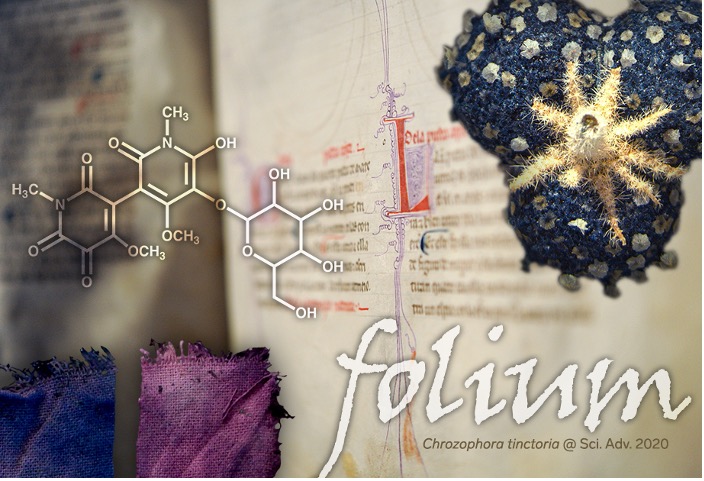 Maths, Physics & Chemistry
Maths, Physics & Chemistry
The 1000-year-old mystery of a medieval blue solved!
To understand why color is fading in precious artworks, the reproduction of ancient colors is a vital ingredient. This know-how was lost at the turn of the 20th century with the rise of industrially-produced synthetic dyes. Retrieving this "lost knowledge" enabled us to solve the mystery of the medieval blue named folium whose molecular structure remained elusive until now.

Lavishly decorated with brightly colored illustrations and ornaments, illuminated manuscripts from the Middle Ages are a feast for the eyes. To preserve these colors for future generations, our group combines methods from the humanities and the natural sciences. In fact, we want to mimic these ancient colors to know how to preserve them. Of all the medieval dyes, folium was the only one whose chemical structure was unknown.
Folium is extracted from the fruits of the Chrozophora tinctoria plant, native in Portugal. The blue/purple folium watercolors were used during Antiquity and the Middle Ages, mainly in the illuminations of precious manuscripts. However, the knowledge of its medicinal and dyeing properties was lost in the 19th century. It is known that Chrozophora tinctoria plant extracts were still used in Grand-Gallargues (France) until the turn of that century, where this blue was captured in cloths, with still medieval techniques; the blue-dyed cloths were later exported to Holland, where it was used to dye red the crust of Dutch cheese. This color transformation from blue into red is another mystery to be solved.
As described by Carolyn Wilke, from Science News, "Unmasking this color's identity took a mix of medieval knowledge and modern science". Indeed, medieval technical knowledge preserved in written sources was crucial to obtain almost pure extracts of folium. We studied several medieval documents and selected three medieval treatises describing in detail the preparation of folium dye to determine the best time for the collection of the fruits of Chrozophora tinctoria and the best way to extract the dye. For example, the 15th-century text, The book on how to make all the color paints for illuminating books, was indispensable in recreating folium. It describes how to extract the blue dye, instructing to squeeze the fruits, being careful not to break the seeds.
Field expeditions lead by Adelaide Clemente, a biologist, collected materials from the Chrozophora tinctoria plant. The plant was found in Southern Portugal (Granja/Mourão) and the fruits were collected during the summer months (from end July into September). The extracts obtained showed a blue dye as the main chromophore. The chromophore, i.e. the molecule responsible for color, was studied at the University of Porto, under the supervision of Victor de Freitas and Joana Oliveira. The purification and characterization of the folium chromophore were challenging, requiring the combination of multiple chemistry techniques (liquid and gas chromatography, mass spectrometry, and nuclear magnetic resonance). However, our efforts lead to the isolation of the molecule of folium which we named chrozophoridin.
The molecule behind folium, chrozophoridin, was used in ancient times to make a beautiful blue dye for painting illuminations, and it is neither an anthocyanin - found in many blue flowers and fruits - nor indigo, the most stable natural blue dye. It turns out to be in a class of its own!
In cultural heritage, understanding and preventing degradation processes involves the chemical structure of a dye. Only in this way, it will be possible to identify folium in artworks and study its properties, enabling new conservation strategies. We hope our work will help to ensure that the future generations can appreciate the vivid colors of medieval illuminations.
Original Article:
Nabais, P. et al. A 1000-year-old mystery solved: Unlocking the molecular structure for the medieval blue from Chrozophora tinctoria, also known as folium. Sci. Adv. 6, 1-9 (2020).
Next read: Tidings from Before the Flood: how Artificial Intelligence Rediscovers Ancient Babylonian Texts by Shai Gordin , Avital Romach , Ethan Fetaya
Edited by:
Dr. Giacomo Rossetti , Senior Scientific Editor
We thought you might like
More from Maths, Physics & Chemistry
Testing gravity through the distortion of time
Sep 20, 2024 in Maths, Physics & Chemistry | 3 min read by Sveva CastelloStacking molecular chips in multiple dimensions
Aug 30, 2024 in Maths, Physics & Chemistry | 3 min read by Lucía Gallego , Romain Jamagne , Michel RickhausReversible Anticoagulants: Inspired by Nature, Designed for Safety
Jun 12, 2024 in Maths, Physics & Chemistry | 4 min read by Millicent Dockerill , Nicolas WinssingerDistance-preserving moves always keep a point fixed
May 18, 2024 in Maths, Physics & Chemistry | 4 min read by Shaula FiorelliA resonance triggers chemical reactions between the coldest molecules
Apr 5, 2024 in Maths, Physics & Chemistry | 3 min read by Juliana Park , Wonyl ChoiEditor's picks
Trending now
Popular topics


